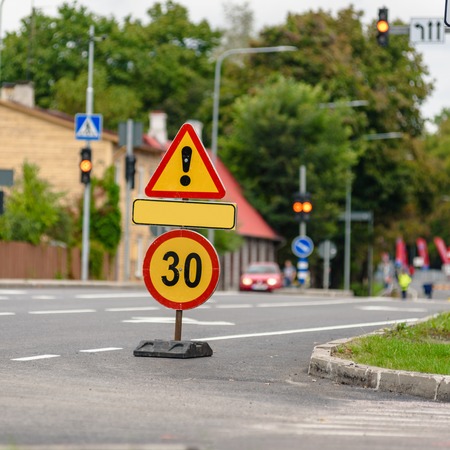Introduction to Pedestrian Crossings in the UK
When you’re touring the British countryside or navigating bustling town centres, pedestrian crossings are a familiar sight. These essential features of the UK’s roads help keep both drivers and pedestrians safe by providing designated points for people to cross the street. The Highway Code outlines specific obligations for drivers at these crossings—regardless of whether you’re rolling through a sleepy village in your campervan or negotiating rush hour in London. Understanding the different types of pedestrian crossings and their unique rules is crucial not only for compliance, but also for fostering road safety throughout Britain.
Overview of Crossing Types
The UK is home to several distinct crossing designs, each marked with specific signs, road markings, and even flashing lights. Here’s a quick guide to some of the most common:
| Crossing Type | Features | Where Youll Find Them |
|---|---|---|
| Zebra Crossing | Black and white stripes on the road; flashing amber Belisha beacons | High streets, village centres, near schools |
| Pelican Crossing | Traffic lights controlled by pedestrians pressing a button | Main urban roads, near shopping areas |
| Puffin Crossing | Sensors that detect pedestrians; pedestrian signals above control box | Modernised city locations |
| Toucan Crossing | Shared by cyclists and pedestrians; bike symbol on signals | Near parks, cycle paths, suburban routes |
The Importance of Pedestrian Crossings
For both seasoned locals and those exploring Britain’s diverse landscapes, pedestrian crossings play a vital role in reducing accidents and enabling everyone to travel safely. Whether you’re parking up your camper for a walk around a market town or driving through remote rural lanes, respecting these crossings is not just a matter of law—it’s part of what makes the British road network welcoming for all.
2. Types of Pedestrian Crossings and Their Features
When driving on UK roads, its essential to recognise the various types of pedestrian crossings and understand your responsibilities at each one. The Highway Code outlines several crossing types, each with its own unique features, road markings, and signals. Knowing these differences not only keeps you compliant with the law but also ensures the safety of all road users.
Zebra Crossings
Zebra crossings are easily identified by their distinctive black and white stripes painted across the road, accompanied by flashing amber Belisha beacons on either side. There are no traffic lights at zebra crossings; instead, drivers must stop and give way to any pedestrian who has set foot on the crossing. This type of crossing relies heavily on driver awareness and courtesy.
Pelican Crossings
Pelican (Pedestrian Light Controlled) crossings use traffic lights to manage both vehicles and pedestrians. When a pedestrian presses the button, the traffic lights will eventually turn red for vehicles, allowing people to cross safely. A unique feature is the flashing amber phase, during which drivers may proceed if the crossing is clear of pedestrians.
Puffin Crossings
Puffin (Pedestrian User-Friendly Intelligent) crossings are similar to Pelican crossings but come equipped with sensors that detect pedestrian movement. Traffic signals remain red for vehicles until all pedestrians have crossed, making them safer and more responsive. The pedestrian signal lights are located beside the waiting area rather than across the street, improving visibility for those crossing.
Toucan Crossings
Toucan crossings allow both pedestrians and cyclists to cross together, usually signposted with a bicycle as well as a walking figure. These crossings are wider than standard pedestrian crossings and are commonly found near cycle paths or parks. Like Puffins, Toucan crossings use push buttons and sensors to control traffic flow.
Pegasus Crossings
Pegasus crossings cater specifically to horse riders as well as pedestrians and sometimes cyclists. They feature an additional high-level push button for equestrians and are often located near bridleways or rural areas where horses regularly cross roads. Signage will display a horse symbol in addition to the usual icons.
Comparison Table: Key Features of UK Pedestrian Crossings
| Crossing Type | Who Can Use It? | Main Feature | Typical Signage/Markings |
|---|---|---|---|
| Zebra | Pedestrians | No lights; driver must give way if pedestrian present | Black & white stripes, Belisha beacons |
| Pelican | Pedestrians | Traffic lights; flashing amber phase | Traffic signals; button-operated box |
| Puffin | Pedestrians | Sensors detect presence; traffic stays red until clear | Button box with nearby signal lights; no stripes on road |
| Toucan | Pedestrians & Cyclists | Wider; shared crossing; sensors used | Bicycle & walking symbols; button-operated signals |
| Pegasus | Pedestrians & Horse Riders (sometimes cyclists) | High-level controls for riders; horse icon signage | Horse symbols; wider crossing; special push buttons |
Understanding these different types of pedestrian crossings—and being able to identify their signs and features—will help you drive confidently and safely across the UK’s diverse network of roads.

3. Driver Responsibilities at Crossings
The UK’s Highway Code is clear about the responsibilities of motorists when approaching pedestrian crossings. As a driver, you must always be alert and ready to yield to pedestrians, adjusting your speed and preparing to stop whenever necessary. The rules vary depending on the type of crossing you encounter, and understanding these differences is vital for both safety and legal compliance.
Key Obligations for Drivers
- Yielding: At all designated pedestrian crossings, drivers are required to give way to anyone who has stepped onto the crossing.
- Stopping: You must stop at the stop line if a pedestrian is waiting or already crossing, particularly at zebra and light-controlled crossings.
- Observing Signals: At signal-controlled (pelican, puffin, toucan) crossings, obey all traffic lights and signals; never move until the crossing is clear and the lights permit you to proceed.
Specifics by Crossing Type
| Crossing Type | Driver Obligation |
|---|---|
| Zebra | Stop if any pedestrian has stepped onto the crossing; do not overtake vehicles stopped at the crossing. |
| Puffin/Pelican/Toucan | Obey red/amber/green signals; only proceed when green and the crossing is clear of pedestrians. |
| Pegasus | Yield to horse riders as well as pedestrians; follow any specific signage or signals for equestrian use. |
Additional Tips for Motorists
- Avoid blocking the crossing when stationary in traffic.
- Be especially cautious in poor visibility or adverse weather—give yourself more time to react.
- Always check both sides for late-crossing pedestrians before moving off.
The Highway Code’s guidance on pedestrian crossings isn’t just a matter of legal obligation—it’s about ensuring everyone’s safety on Britain’s roads. Mastering these rules helps foster a culture of respect between drivers and those on foot, essential for any self-drive adventure across the UK.
4. Common Mistakes and How to Avoid Them
Understanding pedestrian crossings is vital for every driver in the UK, not just to stay on the right side of the Highway Code, but also to keep everyone safe on the road. Here, we break down some of the most frequent misunderstandings drivers face, offer practical advice for those real-life scenarios you’ll encounter – especially when exploring Britain’s scenic routes or bustling towns – and share tips to help you avoid unnecessary fines or accidents.
Frequent Driver Misunderstandings
| Mistake | Explanation | How to Avoid |
|---|---|---|
| Failing to Stop at Zebra Crossings | Some drivers assume pedestrians will wait, but the law requires you to stop if someone is waiting to cross. | Always slow as you approach zebra crossings and be ready to stop if anyone is near the kerb. |
| Misjudging Pelican/Signal-Controlled Crossings | Drivers often rush through amber lights, risking a fine or accident. | If lights are flashing amber, give way to anyone already crossing. Never accelerate to ‘beat’ the light. |
| Blocking Crossings When Queuing in Traffic | Stopping your vehicle over a crossing obstructs pedestrians and can result in penalties. | Keep crossings clear. Only proceed if you can fully clear the crossing area. |
| Ignoring Pedestrian Priorities at Toucan & Puffin Crossings | Some forget cyclists and pedestrians share these crossings; failing to yield can cause incidents. | Watch for both cyclists and pedestrians at these crossings. Always check both sides before proceeding. |
Practical Advice for Real-Life Scenarios
- Weather Awareness: In rain or fog, pedestrian visibility drops. Slow down earlier and double-check crossings for people about to step out.
- Narrow Village Roads: Rural crossings may have limited signage. Approach with extra caution and anticipate sudden pedestrian movement, especially near schools or pubs.
- Night Driving: Pedestrians in dark clothing are harder to spot at night. Use dipped headlights in built-up areas and scan pavements for movement near crossings.
- Campsites & Tourist Spots: Expect higher foot traffic near laybys, picnic areas, and trailheads—be vigilant even where no formal crossing is marked.
Avoiding Fines and Accidents: Quick Tips
- Know Your Signs: Familiarise yourself with UK crossing types (zebra, pelican, puffin, toucan) before heading out on your journey.
- No Phone Distractions: Stay alert—using your mobile while driving increases risk around crossings and could lead to hefty fines under British law.
- Pavement Parking Awareness: In many urban areas, blocking a dropped kerb or crossing point is illegal—always check before parking up for the night!
- Observe Local Habits: In smaller towns or rural areas, informal crossings are common—locals may cross anywhere, so drive with extra care and patience.
Your Road Trip Safety Checklist
- Reduce speed near all crossings—even if you think it’s clear.
- Anticipate pedestrian behaviour—especially children and elderly people who may move unpredictably.
- If unsure whether someone intends to cross, always err on the side of caution and prepare to stop.
- Keen on adventure? Remember: your responsibility as a driver extends beyond your vehicle—every safe crossing makes for a smoother journey across Britain’s beautiful byways!
5. Local Nuances and Cultural Considerations
When driving across the UK, understanding local nuances at pedestrian crossings is as important as following the Highway Code itself. The etiquette and expectations can vary not just from city to countryside, but also between regions, reflecting the rich tapestry of British culture. Below is a guide to help you navigate these differences with confidence.
Regional Differences in Crossing Etiquette
| Region | Common Practices | Driver Expectations |
|---|---|---|
| London & Major Cities | High pedestrian volume, frequent use of crossings, assertive pedestrian behaviour | Always be alert at crossings, anticipate sudden crossings even if signals aren’t active |
| Northern England & Scotland | More relaxed pace, pedestrians may wait longer before crossing, especially in smaller towns | Be patient; do not pressure pedestrians to hurry. Make eye contact and offer a wave if appropriate |
| Coastal & Tourist Areas | Larger groups, families with children, tourists unfamiliar with rules | Extra vigilance required; expect unpredictable stops and slow movement at crossings |
| Rural Villages | Sparser crossings, locals often know each other, informal interactions common | Acknowledge pedestrians with a nod or raised hand; give way even if no formal crossing present |
Urban vs Rural Variations
Urban areas: In cities like London or Manchester, pedestrian crossings are plentiful and clearly marked. Traffic is heavier and both drivers and pedestrians may be more rushed. Expect more traffic lights (Pelican, Puffin, Toucan) and zebra crossings at busy junctions. Here, it’s crucial to stop well before the crossing line and avoid blocking it even during congestion.
Rural areas: Crossings are fewer and less obvious. Pedestrians may cross at any point—especially near village greens or local shops—so always scan the roadside for people preparing to cross. In rural communities, courteous gestures such as a friendly wave are common when giving way.
British Cultural Norms at Crossings
- Politeness matters: It’s typical for British pedestrians to acknowledge drivers who stop for them with a nod or quick wave—a gesture you can reciprocate for goodwill on the road.
- No honking: Using your horn to signal a pedestrian to cross or hurry up is considered rude in the UK; patience is valued over speed.
- Punctual stopping: Stopping just before the white lines at zebra or signal-controlled crossings is expected. Rolling through or stopping late can be seen as disrespectful or intimidating.
- Cyclists and horses: On shared crossings, expect to see cyclists dismounting or equestrians waiting. Always give them plenty of space and time to cross safely.
Cultural Tip for Campers & Road Trippers
If you’re exploring remote areas by campervan or 4×4, remember that small villages value community respect. Going out of your way to allow locals—including schoolchildren and elderly residents—to cross safely will enhance your travel experience and reflect positively on visitors.
6. Consequences of Failing to Comply
Failing to adhere to the rules at pedestrian crossings in the UK is not just a minor oversight—it can have serious consequences for drivers. The Highway Code sets out clear expectations, and breaching these can result in a variety of penalties, legal implications, and negative effects on your car insurance. Here’s a breakdown of what you might face:
Breakdown of Penalties
| Offence | Penalty Points | Fines | Other Consequences |
|---|---|---|---|
| Failing to stop at a zebra crossing | 3 points | Up to £1000 | Potential disqualification |
| Ignoring a red signal at a pelican/puffin crossing | 3 points | Up to £1000 (£2500 for HGVs) | Possible court summons |
| Dangerous driving at a crossing (causing harm) | 3-11 points/ban | Unlimited fine | Court prosecution & possible imprisonment |
Legal Risks You May Face
If your actions at a pedestrian crossing lead to an incident, you could face more than just fines or penalty points. Serious breaches, especially those resulting in injury or death, may lead to prosecution for dangerous or careless driving under UK law. This can mean hefty fines, long-term bans from driving, or even custodial sentences depending on severity. Having any conviction related to pedestrian crossings on your record also impacts your credibility as a responsible driver.
The Impact on Your Insurance
Your car insurance premium is likely to increase significantly after any offence related to pedestrian crossings. Insurers view such violations as indicators of riskier behaviour behind the wheel. Some providers may refuse renewal altogether, or you may be forced onto specialist high-risk policies with limited cover and high costs.
Avoiding Unnecessary Trouble on Your Journeys
If you’re touring the UK—whether on a scenic road trip through the Lake District or camping by Cornwall’s coast—remember that following the Highway Code is essential not just for safety but for peace of mind. A single mistake at a crossing can turn an enjoyable adventure into an expensive legal headache. Stay alert, respect crossings, and keep your travels stress-free!
7. Tips for Motorists on Camp and Road
Whether you’re embarking on a classic British road trip, setting up camp by a scenic riverbank, or just exploring the countryside, being mindful of pedestrian crossings is crucial. The UK’s walking culture is woven into daily life, and as a driver—especially one unfamiliar with local customs—your awareness keeps everyone safe. Here are some handy tips designed for travellers, campers, and road trippers navigating Britain’s diverse roads.
Stay Alert at All Times
Many rural areas popular with campers and hikers are dotted with zebra crossings and informal footpaths leading to village shops, pubs, and trails. Always reduce your speed near these locations and be prepared for sudden pedestrian movements, especially in picturesque spots frequented by families and dog walkers.
Embrace the Country’s Walking Culture
The UK values its public rights of way, so expect to encounter walkers even in remote settings. Respecting pedestrian crossings isn’t just about legal compliance—it’s about joining a culture that celebrates walking as part of everyday life. When approaching crossings in quaint villages or bustling market towns, slow down and give right of way where required.
Common Crossing Types You’ll Encounter
| Crossing Type | Typical Location | Your Obligation |
|---|---|---|
| Zebra Crossing | Town centres, near campsites | Stop if pedestrians are waiting or crossing |
| Puffin/Pelican/Toucan | Main roads, city outskirts | Obey traffic signals; stop on red |
| School Crossing Patrols | Near schools & parks | Stop when signalled by patrol officer |
| Unmarked Crossings | Rural lanes, village greens | Slow down; yield if pedestrians step out unexpectedly |
Handy Reminders for Travellers and Campers
- Early Mornings: Watch for joggers or dog walkers crossing roads near campsites.
- Dusk & Night: Use headlights appropriately—many crossings are poorly lit in the countryside.
- Bicycles & Pushchairs: Give extra space at crossings popular with families or cyclists.
- Towing Caravans: Allow more time to brake and stop when approaching crossings.
Your Adventure, Everyone’s Safety
Navigating the UK by campervan or car offers incredible freedom—but it comes with responsibility. By staying alert at pedestrian crossings and understanding your obligations under the Highway Code, you protect both yourself and Britain’s vibrant community of walkers. Respect the rules, embrace the country’s walking heritage, and enjoy your journey safely from camp to road.


